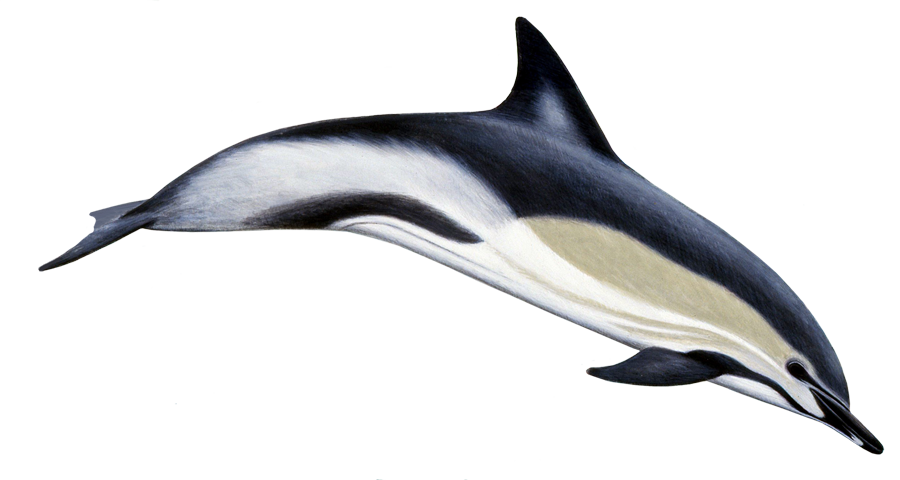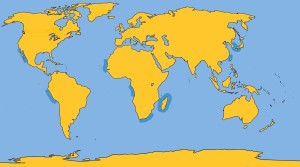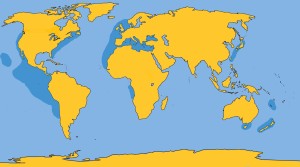 Family: Delphinidae
Family: Delphinidae
Genus: Delphinus
Species: D. delphis Linnaeus, 1758
Taxonomic Note: Other names are sometimes used for variants of the common dolphin: Arabian Sea and Gulf of Aden common dolphin, Delphinus tropicalis; Cape of Good Hope to Gulf of Aden common dolphin, with limited distribution in the Atlantic and Japanese waters, Delphinus capensis; Black Sea common dolphin, Delphinus delphis ponticius.
Although they have been observed near shore, common dolphins more often congregate farther out to sea, sometimes in huge herds of 2,000 individuals or more. The animals will change course for the opportunity to ride bow waves of passing ships.
As with certain species of Stenella, the eastern tropical Pacific common dolphin herds associate with yellowfin tuna. However, their ability to escape tuna nets, learned from experience, has earned them the name “untouchables” among tuna fishermen. Attempts to maintain common dolphins in marine parks or research facilities have often resulted in death from shock or apparent depression.
Until regional variants of the common dolphin are recognized as distinct species, subspecies, or races, all common dolphins will continue to be considered a single species (see Taxonomic Note).
Physical Description: The body is long and slender with very well defined features. The length of the beak and the color pattern are perhaps the best keys to identification among regional variants.
Color: The common dolphin’s basic pattern is black dorsally from the beak to the center of the peduncle, extending downward under the dorsal fin in the shape of an upside-down triangle. The flanks are gray from the eye to the tail. The white color of the ventral region extends upwards at the sides in a triangle, the tip of which meets the darker dorsal region to form an hourglass or crisscross configuration. The rostrum is usually black with a white tip. The dark chin color extends broadly to the leading margin of the flippers where it blends with the dark flipper color. The demarcation of the beak and forehead is defined by a thin dark line extending out to meet the dark eye patch.
Fins and Flukes: The prominent falcate dorsal fin is rounded at the top and located on the mid-back region. The dark flippers are long, thin, and slightly rounded or pointed, depending on regional variations. The flukes are thin, pointed at the tips, with a slight median notch.
Length and Weight: These animals reach a length of 7 to 8 ft (2.1 to 2.4 m), and weigh between 200 and 300 lb (91 to 136 kg). Mature males are normally 4 to 8 in (10 to 20 cm) longer than females.
Teeth: An average of 40 to 50 small, pointed teeth are located in each side of the upper and lower jaws.
Feeding: Common dolphins feed on schools of migrating fish such as anchovies, herring, and sardines; also squid.
Breathing and Diving: These animals can dive as deep as 900 ft (280 m) and remain down as long as eight minutes. There appears to be a daily cycle of activity during which small feeding groups scatter in the late afternoon to feed on rising organisms in the deep scattering layer (DSL). When the DSL returns to deeper waters, the groups come together again for rest or social interaction.
Mating and Breeding: Calves of 30 to 24 in (76 to 86 cm) are born every 1.3 years in spring and fall after a gestation period of 10 to 11 months. Calves are weaned at between 1 and 3 years. Sexual maturity is reached when the animal is about 3 to 4 years old and 5.5 to 6 ft (1.67 to 1.8 m).
Herding: Herds of up to 3,000 are not uncommon.
Distribution: They are found in the North and South Pacific and Indian oceans, and are widely distributed in warmer temperate and tropical waters of all oceans including the Black Sea.
Migration: Most populations seem to follow the movements of food fish.
LONG-BEAKED COMMON DOLPHIN DISTRIBUTION
SHORT-BEAKED COMMON DOLPHIN DISTRIBUTION








